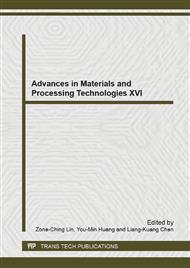[1]
Y. Murakami and T. Toriyama, Critical Review of the Inclusion Rating by JIS-G-0555 Method and New Inclusion Rating Based on Statistics of Extreme and its Application, Journal of the Iron and Steel, Vol. 79 (1993) 76-81.
DOI: 10.2355/tetsutohagane1955.79.12_1380
Google Scholar
[2]
G. Auclair, F. Ruby-Meyer, R. Meilland and P. Rocabois, Cleanliness Assessment: A Critical Review and a Real Need to Predict Rolling Contact Fatigue Behavior, Bearing Steels: Into the 21st century, ASTM STP 1327, ASTM International, West Conshohocken, PA, 1998, pp.40-54.
DOI: 10.1520/stp12119s
Google Scholar
[3]
T. B. Lund, S. A. Johansson and L. J. P. Olund, Nucleation of Fatigure in Very Low Oxygen Bearing Steels, Bearing Steels: Into the 21st century, ASTM STP 1327, ASTM International, West Conshohocken, PA, 1998, pp.125-126.
DOI: 10.1520/stp12124s
Google Scholar
[4]
K. Wee and K. S. Lee, The Study of Low Carbon Microalloyed Forging Steels by Direct Quenching Method With Mo Addition, Korean Journal of Materials Research, Vol. 2, No. 6 (1992) 452-457.
Google Scholar
[5]
T. Yokota, A. Kobayashi, T. Arigo, K. Funakawa and K. Seto, Development of Ultra-Fine Precipitation Hardened Hot-Rolled High Strength Steel nd Its Application to Automotive Use, Innovations in Steel Sheet and Bar Products and Processing, SP-1951, SAE International, Warrendale, PA, 2005, pp.79-84.
DOI: 10.4271/2005-01-1328
Google Scholar
[6]
S. Yue, J. D. Boyd, L. Mallory, M. Militzer and E. Essadiqui, Microstructural Developments in Advanced High Strength Steels, Innovations in Steel Sheet and Bar Products and Processing, SP-1951, SAE International, Warrendale, PA, 2005, pp.85-90.
DOI: 10.4271/2005-01-1329
Google Scholar
[7]
T. H. Huh, J. Y. Kim and B. H. Hahn, Influence of Nb Addition on the Austenite Grain Growth of Ti-Microalloyed Steels, Journal of Korean Of Metals and Materials, Vol. 35, No. 9 (1997) 1077-1083.
Google Scholar
[8]
Li Zheng and Xu Minghua, Study of Vacuum Carbon-Deoxidization of High Carbon Chromium Bearing Steel, Bearing Steel Technology: Advances and State-of-the-Art in Bearing Steel Quality Assurance, ASTM STP 1327, ASTM International, West Conshohocken, PA, 2007, pp.19-24.
DOI: 10.1520/stp41635s
Google Scholar
[9]
S. Beretta and Y. Murakami, Statistical Analysis of Deffects for Fatigue Strength Prediction and Quality Control of Materials, Fatigue & Fracture of Engineering Materials & Structures, Vol. 21 (1998) 1049-1065.
DOI: 10.1046/j.1460-2695.1998.00104.x
Google Scholar
[10]
Information on http: /www. jfe-21st. cf. or. jp.
Google Scholar
[11]
A. Kerrigan, J. C. Kuijpers and E. Ioannides. Cleanliness of Bearing Steels and Fatigue Life of Rolling Contacts, Bearing Steel Technology: Advances and State-of-the-Art in Bearing Steel Quality Assurance, ASTM STP 1465, ASTM International, West Conshohocken, PA, 2007, pp.103-106.
DOI: 10.1520/stp41643s
Google Scholar
[12]
Dennis W. Hetzner, Developing ASTM E 2283: Standard Practice for Extreme Value Analysis of Nonmetallic Inclusions in Steel and Other Microstructural Features, Bearing Steel Technology: Advances and State-of-the-Art in Bearing Steel Quality Assurance ASTM STP 1465, ASTM International, West Conshohocken, PA, 2007, pp.67-84.
DOI: 10.1520/stp41641s
Google Scholar
[13]
F. A. Morrison, Using the Solver Add-in in Microsoft Excel, fmorriso@mtu. edu, 2006, pp.1-7.
Google Scholar


